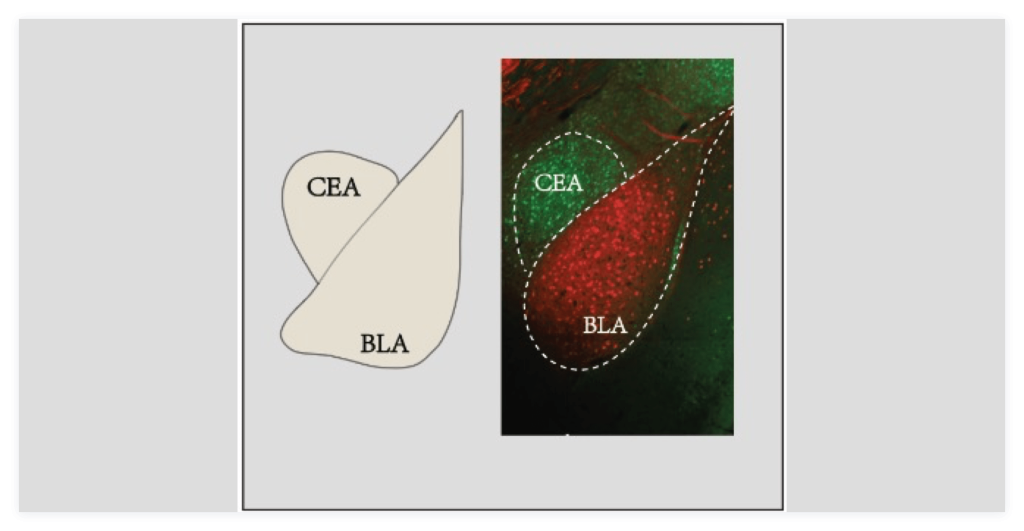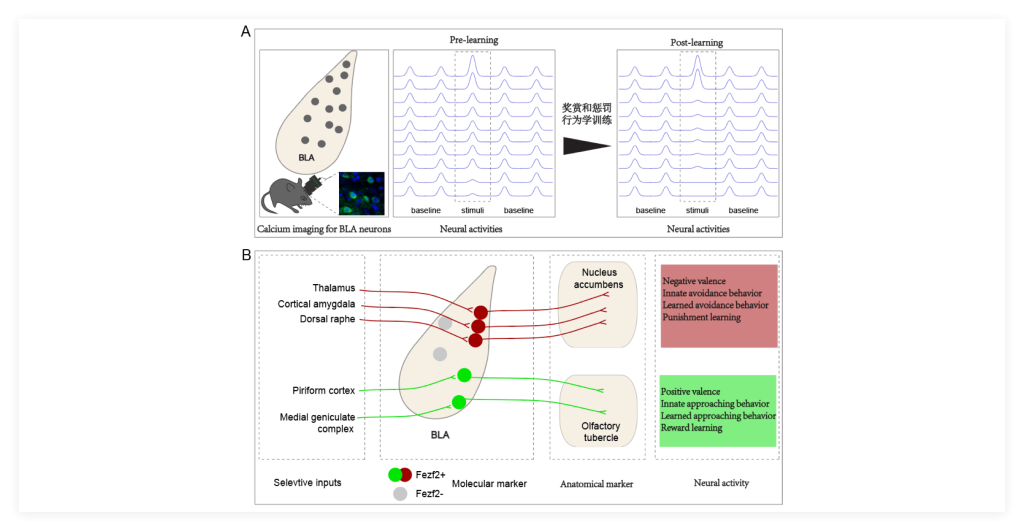
情绪与动机行为的神经机制研究

We experience a wide range of emotions such as joy, anger, sadness, which influence our behavior and make our daily lives colorful. However, emotions can also become demons, by which emotional disorders and maladaptive motivational behavior can lead to the development of many psychiatric disorders, including anxiety disorders, depression, and post-traumatic stress disorder. There is a brain region named amygdala, which is the subcortical center of the limbic system and is a highly conserved evolutionary brain region responsible for processing emotions, motivation, etc. and various behaviors. Therefore, the study of the structure and function of the amygdala has an important role in understanding the pathogenesis of psychiatric disorders. The amygdala includes the basolateral nucleus (BLA) and the central nucleus (CEA) (Figure 1), the present study focuses on researches on the BLA subregion.
1. Elucidate the encoding properties of BLA excitatory neurons for emotional valence and motivated behavior.
In terms of cell type and development, the BLA is similar to the cerebral cortex and has been a research hotspot in the field of neuroscience in recent years. Traditional research uses conditional fear learning as a breakthrough point to record the intracellular or extracellular electrophysiological characteristics of BLA neurons before and after learning. This type of research has significant limitations: firstly, it cannot effectively study positive and negative emotions simultaneously; secondly, it cannot obtain the population response characteristics of high-throughput neurons. To solve these problems, we designed a behavioral learning system that can simultaneously perform reward and punishment learning and combined it with high-throughput in vivo calcium signal fluorescence imaging methods to systematically study the encoding rules of BLA neuron populations for emotional valence and motivated behavior before, during, and after associative learning. Unlike the classic Hebbian plasticity theory, there was no significant increase in the number of excitatory neurons in the mouse amygdala after behavioral learning. Surprisingly, the inhibitory response of the neuron population significantly increased, accompanied by a reduction in noise correlation among neurons (Figure 1A). This series of results suggests that after reward and punishment learning, mice increase their attention to conditional stimuli by inhibiting the activity of most non-relevant neurons to improve signal-to-noise ratio, enabling task-specific neurons to more accurately encode information and perform corresponding behavioral actions more accurately and efficiently.
2. Understanding circuitry mechanisms of genetic-defined BLA neurons (Fezf2+) for emotional valence and motivated behavior.

How can we find the neurons in the BLA that directly encode emotion and observe animal behavior by activating/inhibiting such neurons? Marking subregions of neurons with specific gene expression or specific neural pathways is a commonly used research method. The Fezf2 gene is a highly conserved gene fragment that encodes a transcription factor critical for the development of excitatory neurons. We first used in vivo single-photon calcium signal imaging for real-time imaging of Fezf2-expressing neurons in the basolateral amygdala and found that these neurons fall into two broad categories: one encoding rewarding stimuli and the other encoding punishing stimuli. The experimental mice were next trained for conditioned learning and more neurons were found to be involved in the encoding of conditioned stimuli. We then traced the upstream and downstream neural circuits of these two classes of neurons and found that different upstream and downstream brain regions were involved in encoding different emotional information (Figure 1. B). Of most interest are the two neural pathways from the basolateral amygdala (BLA) to the ventral striatum: basolateral amygdala-nucleus accumbens (BLA-NAc), and basolateral amygdala-olfactory tubercle (BLA-OT), respectively. The NAc and OT, as two subregions of the ventral striatum, have been traditionally considered as a relay station for emotional responses and behavioral activities. the function of BLA-NAc pathway has been controversial in previous reports in the literature, and the function of BLA-OT pathway has never been reported. Experimental results from optogenetic studies indicate that activation of the BLA-NAc and BLA-OT pathways causes animals to exhibit punishment-avoidance and reward-seeking behaviors, respectively, while both are accompanied by significant pupil dilation. This combination of behavioral and physiological responses implies that these two pathways should also have an important role in emotional learning. To test this hypothesis, We used optogenetic and chemical genetic methods to inhibit the neural activity of these two pathways and found that the inhibition impaired punishment learning and reward learning, respectively. The results provide new insights into the neural mechanisms of reward and motivated behavior and lay a foundation for the development of targeted treatments for related mental illnesses.